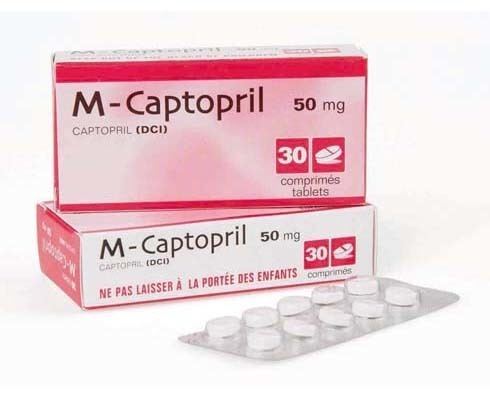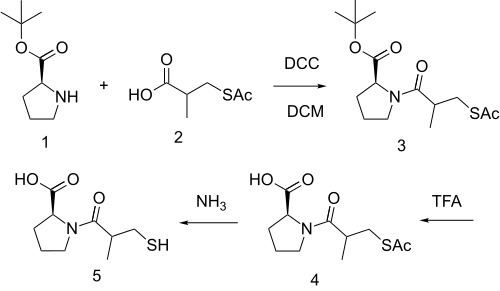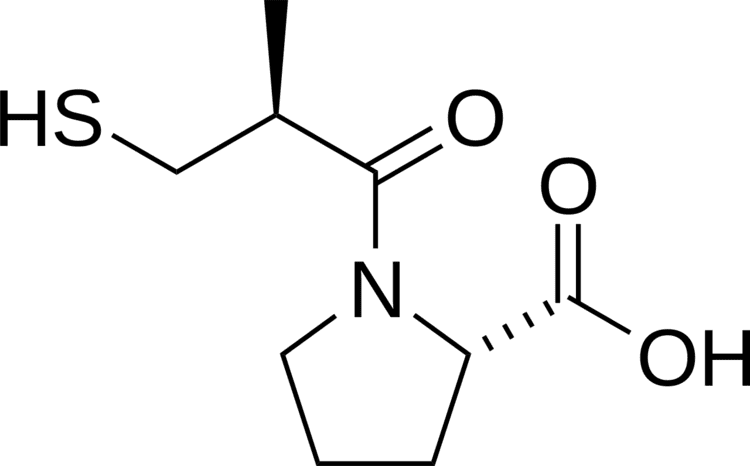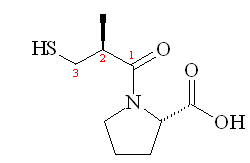Pronunciation /ˈkæptəprɪl/ AHFS/Drugs.com Monograph Routes ofadministration Oral CAS ID 62571-86-2 | Trade names Capoten MedlinePlus a682823 Molar mass 217.29 g/mol | |
 | ||
Pregnancycategory AU: DUS: D (Evidence of risk) | ||
Captopril, sold under the trade name Capoten, is an angiotensin-converting enzyme (ACE) inhibitor used for the treatment of hypertension and some types of congestive heart failure.
Contents
- Medical uses
- History
- Chemical synthesis
- Pharmacokinetics
- Limitations of captopril
- Subsequent ACE inhibitors
- Adverse effects
- Overdose
- References

Captopril was discovered in 1977. It was the first ACE inhibitor developed and was considered a breakthrough both because of its novel mechanism of action and also because of the revolutionary development process. Captopril was discovered and developed at E. R. Squibb & Sons Pharmaceuticals based on concepts pioneered by Nobel Laureate John Vane and is now marketed by Bristol-Myers Squibb.

Medical uses

Captopril's main uses are based on its vasodilation and inhibition of some renal function activities. These benefits are most clearly seen in: 1) Hypertension 2) Cardiac conditions such as congestive heart failure and after myocardial infarction 3) Preservation of kidney function in diabetic nephropathy

Additionally, it has shown mood-elevating properties in some patients. This is consistent with the observation that animal screening models indicate putative antidepressant activity for this compound, although one study has been negative. Formal clinical trials in depressed patients have not been reported.

It has also been investigated for use in the treatment of cancer. Captopril stereoisomers were also reported to inhibit some metallo-β-lactamases.
History
Captopril was developed in 1975 by three researchers at the U.S. drug company Squibb (now Bristol-Myers Squibb): Miguel Ondetti, Bernard Rubin, and David Cushman. Squibb filed for U.S. patent protection on the drug in February 1976 and U.S. Patent 4,046,889 was granted in September 1977.
The development of captopril was among the earliest successes of the revolutionary concept of ligand-based drug design. The renin-angiontensin-aldosterone system had been extensively studied in the mid-20th century, and this system presented several opportune targets in the development of novel treatments for hypertension. The first two targets that were attempted were renin and ACE. Captopril was the culmination of efforts by Squibb's laboratories to develop an ACE inhibitor.
Ondetti, Cushman, and colleagues built on work that had been done in the 1960s by a team of researchers led by John Vane at the Royal College of Surgeons of England. The first breakthrough was made by Kevin K.F. Ng in 1967, when he found the conversion of angiotensin I to angiotensin II took place in the pulmonary circulation instead of in the plasma. In contrast, Sergio Ferreira found bradykinin disappeared in its passage through the pulmonary circulation. The conversion of angiotensin I to angiotensin II and the inactivation of bradykinin were thought to be mediated by the same enzyme.
In 1970, using bradykinin potentiating factor (BPF) provided by Sergio Ferreira, Ng and Vane found the conversion of angiotensin I to angiotensin II was inhibited during its passage through the pulmonary circulation. BPF was later found to be a peptide in the venom of a lancehead viper (Bothrops jararaca), which was a “collected-product inhibitor” of the converting enzyme. Captopril was developed from this peptide after it was found via QSAR-based modification that the terminal sulfhydryl moiety of the peptide provided a high potency of ACE inhibition.
Captopril gained FDA approval on April 6, 1981. The drug became a generic medicine in the U.S. in February 1996, when the market exclusivity held by Bristol-Myers Squibb for captopril expired.
The development of captopril has been claimed as an instance of 'biopiracy' (commercialization of traditional medicines), since no benefits have flowed back to the indigenous Brazilian tribe who first used pit viper venom as an arrowhead poison.
Chemical synthesis
A chemical synthesis of captopril by treatment of L-proline with (2S)-3-acetylthio-2-methylpropanoyl chloride under basic conditions (NaOH), followed by aminolysis of the protective acetyl group to unmask the drug's free thiol, is depicted in the figure at right.
Procedure 2 taken out of patent US4105776. See examples 28, 29a and 36.
Pharmacokinetics
Unlike the majority of ACE inhibitors, captopril is not administered as a prodrug (the only other being lisinopril). About 70% of orally administered captopril is absorbed. Bioavailability is reduced by presence of food in stomach. It is partly metabolised and partly excreted unchanged in urine.
Limitations of captopril
The adverse drug reaction (ADR) profile of captopril is similar to other ACE inhibitors, with cough being the most common ADR. However, captopril is also commonly associated with rash and taste disturbances (metallic or loss of taste), which are attributed to the unique thiol moiety.
Captopril also has a relatively poor pharmacokinetic profile. The short half-life necessitates two or three times per day dosing, which may reduce patient compliance.
Subsequent ACE inhibitors
The adverse effect and pharmacokinetic limitations of captopril stimulated the development of enalapril and subsequent ACE inhibitors. These were specifically designed to lack the sulfhydryl moiety believed to be responsible for rash and taste disturbance. Most subsequent ACE inhibitors are given as prodrugs, to improve oral bioavailability. All have longer half-lives and are given once or twice daily, which may improve patient compliance.
Adverse effects
Adverse effects of captopril include cough due to increase in the plasma levels of bradykinin, angioedema, agranulocytosis, proteinuria, hyperkalemia, taste alteration, teratogenicity, postural hypotension, acute renal failure, and leukopenia. Except for postural hypotension, which occurs due to short and fast mode of action of captopril, most of the side effects mentioned are common for all ACE inhibitors. Among these, cough is the most common adverse effect. Hyperkalemia can occur, especially if used with other drugs which elevate potassium level in blood, such as potassium-sparing diuretics. Other side effects are:
Overdose
Captopril (as other ACE inhibitors) overdose can be antagonized with naloxone.
